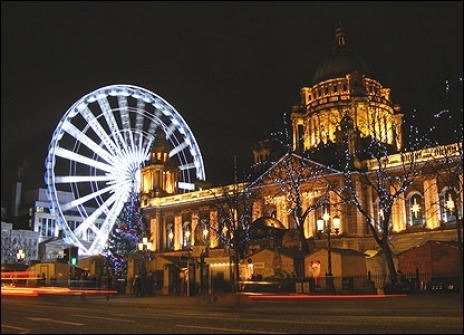City of Belfast

Belfast may be the one city in the world that hides its beauty and loudly displays it problems. The city is full of amazing places. From the modern Victoria Square and Odyssey, the classical architecture of Queens University, Belfast City Hall, Church House, and the Opera House, the natural wonder of Cave Hill and the Botanical Gardens, and the historic Carrickfergus Castle , Ulster Folk Museum, and Scrabo Tower, Belfast is lined with great sights. The city itself is situated between the Belfast Lough to its east and untouched, rolling green hills to the west. Every neighborhood is full of multiple parks. A block away from me is The Grove playing fields, which has eight football fields and a great trail that overlooks the old shipyards that built the Titanic. A quarter mile up the street from that is the city Waterworks, a lake a half mile around at the base of Cave Hill, and my favorite place to run (when it isn’t raining).
The city is full of small local football teams, the national Northern Ireland football team that defeated both England and Spain in 2006, the Ulster Rugby team, and the Belfast Giants, a rare ice hockey team that is actually very good. But the most supported sports teams in Northern Ireland don’t play in Northern Ireland. They play in Scotland. The two sides of the conflict identify themselves with two football teams that play in Glasgow, the Rangers (supported by Protestants) and Celtic (supported by Catholics). Many local pubs proudly proclaim that they operate for the supporters of one club or the other, clearly stating whether they are Republican (Catholic) or Loyalist (Protestant). Many other pubs wave either British or Irish flags , as do restaurants and homeowners. People decorate their homes with national flags the way that Americans would decorate with pennants of their favorite sports teams, unabashedly showing which side of the conflict they are on. It does not take long once a person has entered a neighborhood to realize whether it is a Protestant or Catholic one. And most youth will never even go to school with youth who aren’t from their background. Only 5% of schools are integrated.

As I go north on the Shore Road on my way to work each day, I pass a huge two story mural of a paramilitary soldier dressed in all black carrying an automatic rifle painted on the side of a housing development. A few houses down from it is another mural and another paramilitary soldier painted on it with the words: “Prepared for Peace/Ready for War.” This is not a rare occurrence. The city is full of murals either with paramilitary soldiers on it or paintings supporting either the IRA or the UDA. Miles of “peace walls” cover parts of the city, especially north Belfast. Peace walls are walls of concrete, metal, and barbed wire put up between Protestant and Catholic neighborhoods to keep down violence between the two communities.
The problems that Belfast has are obvious to anyone who looks around the city. But violence is statistically less here than in almost any American city and even many cities in England and Scotland. And the place is full of a lot of hope right now. Anyone who is over the age of 20 and has grown up here has been able to tell me just how much the area has improved in the past 15 years and how much safer it is for them than when they grew up. Churches continue to work hard to bring the community together. Overall, people feel that peace in Northern Ireland is a real possibility and they’ve seen great shifts towards it in the very recent past. But there sill exists a lot of work that has to be done in order to reconcile two communities together who hardly interact with each other.
